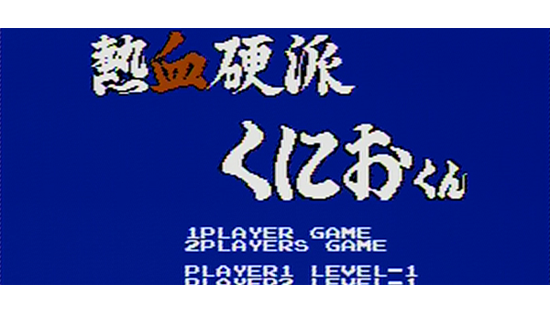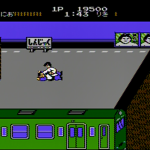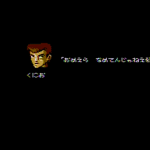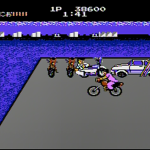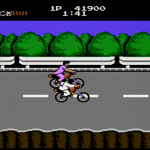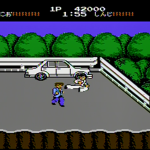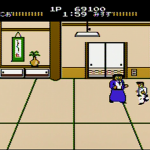Famicom ports of early arcade games often turned out to be far cries from their originals, though they meant well. Development on the Famicom just hadn’t been refined to the point where truly accurate ports of these titles were feasible, and these were the days where arcade technology was so far beyond home console technology that it was often impossible. Kunio’s Famicom port changes up a great many things from the original. The most noticeable is a graphical style that’s significantly closer than the arcade version to that which the Kunio series would become so well known for in its next installment. The music is also incredibly faithful to the original version. There’s an alternating 2 player mode here, which was typical for Famicom beat-em-ups of the time. Each player can also select one of three levels, which seem to do nothing more than change the stage backgrounds between daytime, dusk, and nighttime. Power ups will also appear periodically that will refill health, or temporarily increase strength or speed.
Due to hardware limitations each level would also be broken up into multiple screens (the transitions typically being going through doorways), with less enemies on screen at any given time. Full health refills are also given on each new screen, and bosses are always fought one-on-one. While the game doesn’t allow for continues, it does give three lives by default. These factors not only make the game feel very different from the original, but makes it feel considerably easier as a result. Here’s a run down of each of the four stages, along with their significant differences in the Famicom and NES ports:
Stage 1:
The first fight against the thugs from Hanazono High School takes place on a train platform. The boss is Riki, who would become Kunio’s rival as the series developed. The Famicom version added the transition to the inside of the the train car, and the place where you fight Riki is now on a different platform at Shinjuku Station. In Renegade this was changed to a generic subway platform.
Stage 2:
This fight takes place in a bay area against the bousouzoku group “Yokohama Funky”, the boss being Shinji. The Famicom version still features the annoying motorcycles (though they don’t come first), which still require you to get the timing down but are much easier due to only one of them being on screen at a time. A bike chase scene was also added in, requiring you to knock enemies off their bikes from above or below. In Renegade the enemies were changed to death metal-looking characters.
Stage 3:
Here we fight with the girls gang of Taiyou Gakuen outside of a disco, the boss is an imposing lady named Misuzu. She presents the first truly challenging boss pattern in either version (you need to back off to bait her run, then jump kick her as she gets close). The Famicom version actually features a choice of routes, so you can clear the stage even without fighting Misuzu. In Renegade the enemy costumes were changed to resemble female pro wrestlers.
Stage 4:
The boss here is Sabu, and you fight him outside of the Sanwa Kai headquarters (some sort of well known violent gang). Difficulty goes up even further here, with the normal enemies having knives that one-shot-kill in the arcade, and just being generally harder on the Famicom. Sabu himself even has a pistol that rapidly depletes health. Unfortunately the Famicom version has a small door maze inside of the building, requiring you to choose the correct route to proceed with the level. The boss remained unchanged in Renegade, but the regular enemies were changed to resemble what I assume are black gang members (this was the late 80s after all). The home version also features more of an ending, complete with a credit sequence, instead of just looping the game after a quick scene.
This is by no means a perfect port of the original arcade version of Kunio kun, but it feels like that was never really the intent behind it. It’s a port that tries to be close enough, but on its own terms by changing up some things to make up for the fact that it couldn’t really be accurately ported at this point in the Famicom’s life. While it doesn’t have the distinct graphical style of the original, it keeps the basic flavor in just about every other way. It’s also considerably less challenging due to the previously mentioned hardware limitations, so it may be a better option for someone set on finishing the game.
The Famicom/NES version appears on the Wii, 3DS and Wii U Virtual Consoles. A South America only version on the Master System was also released in 1993. It’s based on the NES version, developed by Natsume and published by Sega.
